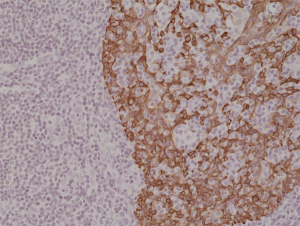
Immunohistochemical staining of formalin fixed and paraffin embedded human tonsil tissue section using anti-CK-14 rabbit monoclonal antibody (Clone RM328) at a 1:2000 dilution.
anti-Cytokeratin-14 (human), Rabbit Monoclonal (RM328)
REV-31-1215-00
ApplicationsWestern Blot, ImmunoHistoChemistry
Product group Antibodies
TargetKRT14
Overview
- SupplierRevMAb Biosciences
- Product Nameanti-Cytokeratin-14 (human), Rabbit Monoclonal (RM328)
- Delivery Days Customer10
- ApplicationsWestern Blot, ImmunoHistoChemistry
- CertificationResearch Use Only
- ClonalityMonoclonal
- Clone IDRM328
- Gene ID3861
- Target nameKRT14
- Target descriptionkeratin 14
- Target synonymsCK14, EBS1, EBS1A, EBS1B, EBS1C, EBS1D, EBS3, EBS4, K14, NFJ, keratin, type I cytoskeletal 14, cytokeratin 14, keratin 14, type I
- HostRabbit
- IsotypeIgG
- Protein IDP02533
- Protein NameKeratin, type I cytoskeletal 14
- Scientific DescriptionCytokeratins are keratin proteins found in the intracytoplasmic cytoskeleton of epithelial tissue (at least 20 different polypeptides). They are an important component of intermediate filaments, which help cells resist mechanical stress. Expression of these cytokeratins within epithelial cells is largely specific to particular organs or tissues. The subsets of cytokeratins which an epithelial cell expresses depends mainly on the type of epithelium, the moment in the course of terminal differentiation and the stage of development. Thus a specific cytokeratin expression profile allows the identification of epithelial cells. Furthermore, this applies also to the malignant counterparts of the epithelia, (carcinomas). Cytokeratin subtype expression patterns are used to an increasing extent in the distinction of different types of epithelial malignancies. The cytokeratin antibodies are not only of assistance in the differential diagnosis of tumors using immunohistochemistry on tissue sections, but are also a useful tool in cytopathology and flow cytometric assays. Cytokeratin-14 (CK14) is a type I cytokeratin found in basal cell of squamous epithelia, some glandular epithelia, myoepithelium and mesothelial cells. Cytokeratin-14 is specifically expressed in the basal layer of the epidermis along with cytokeratin-5. Anti-CK14 has been demonstrated to be useful in differentiating squamous cell carcinomas from other epithelial tumors. It is considered a prognostic marker in breast carcinomas. - Recombinant Antibody. This antibody reacts to human Cytokeratin-14. It may also react to mouse or rat Cytokeratin-14, as predicted by immunogen homology. Applications: WB, IHC. Source: Rabbit. Liquid. 50% Glycerol/PBS with 1% BSA and 0.09% sodium azide. Cytokeratins are keratin proteins found in the intracytoplasmic cytoskeleton of epithelial tissue (at least 20 different polypeptides). They are an important component of intermediate filaments, which help cells resist mechanical stress. Expression of these cytokeratins within epithelial cells is largely specific to particular organs or tissues. The subsets of cytokeratins which an epithelial cell expresses depends mainly on the type of epithelium, the moment in the course of terminal differentiation and the stage of development. Thus a specific cytokeratin expression profile allows the identification of epithelial cells. Furthermore, this applies also to the malignant counterparts of the epithelia, (carcinomas). Cytokeratin subtype expression patterns are used to an increasing extent in the distinction of different types of epithelial malignancies. The cytokeratin antibodies are not only of assistance in the differential diagnosis of tumors using immunohistochemistry on tissue sections, but are also a useful tool in cytopathology and flow cytometric assays. Cytokeratin-14 (CK14) is a type I cytokeratin found in basal cell of squamous epithelia, some glandular epithelia, myoepithelium and mesothelial cells. Cytokeratin-14 is specifically expressed in the basal layer of the epidermis along with cytokeratin-5. Anti-CK14 has been demonstrated to be useful in differentiating squamous cell carcinomas from other epithelial tumors. It is considered a prognostic marker in breast carcinomas.
- Storage Instruction-20°C
- UNSPSC12352203




